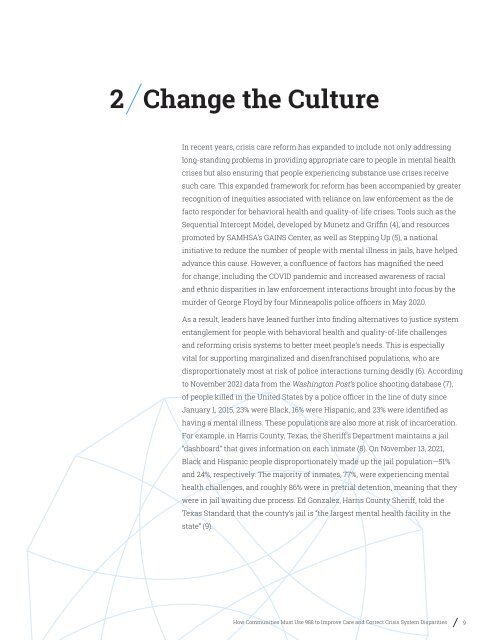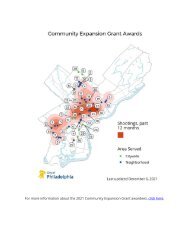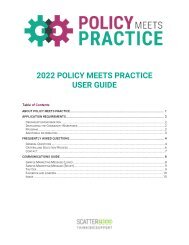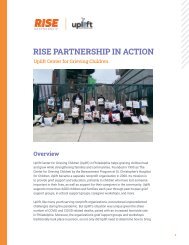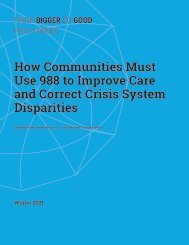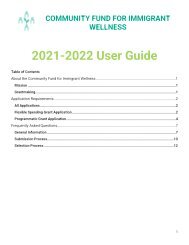How Communities Must Use 988 to Improve Care and Correct Crisis System Disparities
Create successful ePaper yourself
Turn your PDF publications into a flip-book with our unique Google optimized e-Paper software.
2<br />
Change the Culture<br />
In recent years, crisis care reform has exp<strong>and</strong>ed <strong>to</strong> include not only addressing<br />
long-st<strong>and</strong>ing problems in providing appropriate care <strong>to</strong> people in mental health<br />
crises but also ensuring that people experiencing substance use crises receive<br />
such care. This exp<strong>and</strong>ed framework for reform has been accompanied by greater<br />
recognition of inequities associated with reliance on law enforcement as the de<br />
fac<strong>to</strong> responder for behavioral health <strong>and</strong> quality-of-life crises. Tools such as the<br />
Sequential Intercept Model, developed by Munetz <strong>and</strong> Griffin (4), <strong>and</strong> resources<br />
promoted by SAMHSA’s GAINS Center, as well as Stepping Up (5), a national<br />
initiative <strong>to</strong> reduce the number of people with mental illness in jails, have helped<br />
advance this cause. <strong>How</strong>ever, a confluence of fac<strong>to</strong>rs has magnified the need<br />
for change, including the COVID p<strong>and</strong>emic <strong>and</strong> increased awareness of racial<br />
<strong>and</strong> ethnic disparities in law enforcement interactions brought in<strong>to</strong> focus by the<br />
murder of George Floyd by four Minneapolis police officers in May 2020.<br />
As a result, leaders have leaned further in<strong>to</strong> finding alternatives <strong>to</strong> justice system<br />
entanglement for people with behavioral health <strong>and</strong> quality-of-life challenges<br />
<strong>and</strong> reforming crisis systems <strong>to</strong> better meet people’s needs. This is especially<br />
vital for supporting marginalized <strong>and</strong> disenfranchised populations, who are<br />
disproportionately most at risk of police interactions turning deadly (6). According<br />
<strong>to</strong> November 2021 data from the Washing<strong>to</strong>n Post’s police shooting database (7),<br />
of people killed in the United States by a police officer in the line of duty since<br />
January 1, 2015, 23% were Black, 16% were Hispanic, <strong>and</strong> 23% were identified as<br />
having a mental illness. These populations are also more at risk of incarceration.<br />
For example, in Harris County, Texas, the Sheriff’s Department maintains a jail<br />
“dashboard” that gives information on each inmate (8). On November 13, 2021,<br />
Black <strong>and</strong> Hispanic people disproportionately made up the jail population—51%<br />
<strong>and</strong> 24%, respectively. The majority of inmates, 77%, were experiencing mental<br />
health challenges, <strong>and</strong> roughly 86% were in pretrial detention, meaning that they<br />
were in jail awaiting due process. Ed Gonzalez, Harris County Sheriff, <strong>to</strong>ld the<br />
Texas St<strong>and</strong>ard that the county’s jail is “the largest mental health facility in the<br />
state” (9).<br />
<strong>How</strong> <strong>Communities</strong> <strong>Must</strong> <strong>Use</strong> <strong>988</strong> <strong>to</strong> <strong>Improve</strong> <strong>Care</strong> <strong>and</strong> <strong>Correct</strong> <strong>Crisis</strong> <strong>System</strong> <strong>Disparities</strong> 9


